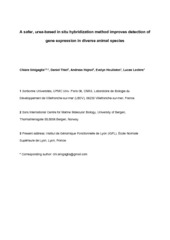| dc.description.abstract | In situ hybridization is a widely employed technique allowing spatial visualization of gene expression in fixed specimens. It has proven to be essential to our understanding of biological processes, including developmental regulation. In situ protocols are today routine in numerous laboratories, and although details might change, they all include a hybridization step, where specific antisense RNA or DNA probes anneal to the target nucleic acids strand. This step, in general, is carried out at high temperatures and in a denaturing solution, the hybridization buffer, commonly containing 50% (v/v) formamide. An important drawback is that hot formamide poses a significant health risk and so must be handled with great care. We were prompted to test alternative hybridization solutions for in situ detection of gene expression in the medusa of the hydrozoan Clytia hemisphaerica, where traditional protocols caused extensive deterioration of the morphology and texture during hybridization, hindering observation and interpretation of results. Inspired by optimized protocols for Northern and Southern blot analysis, we substituted the 50% formamide with an equal volume of 8 M urea solution in the hybridization buffer. The new protocol yielded better morphologies and consistency of tissues, and also notably improved the resolution of the signal, allowing more precise localization of gene expression, as well as reduced staining at non-specific sites. Given the improved results using a less toxic hybridization solution, we tested the urea protocol on a number of other metazoans: two brachiopod species (Novocrania anomala and Terebratalia transversa) and the worm Priapulus caudatus, obtaining a similar reduction of aspecific probe binding. Overall, substitution of formamide by urea in in situ hybridization offers safer alternative protocols, potentially useful in research, medical and teaching contexts. We encourage other workers to test this approach on their study organisms, and hope that they will also obtain better sample preservation, more precise expression patterns and fewer problems due to aspecific staining, as we report here for Clytia medusae and Novocrania and Terebratalia developing larvae. | en_US |

